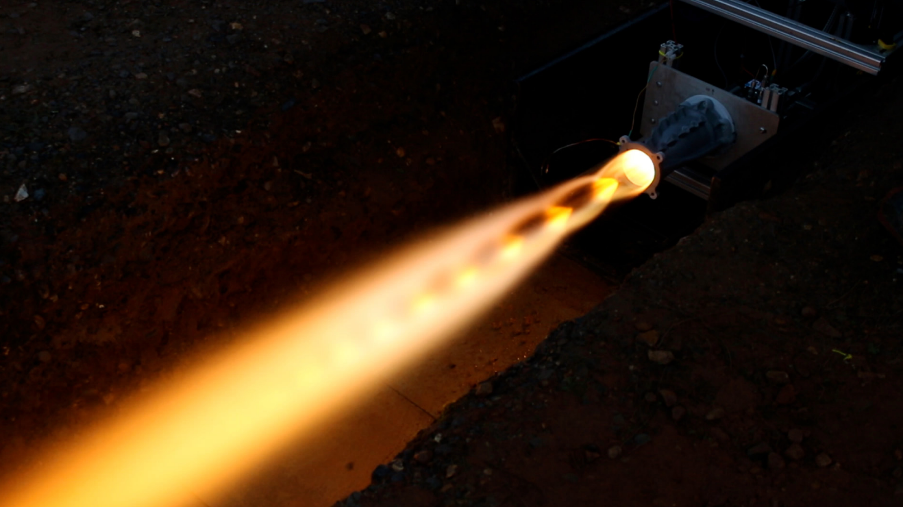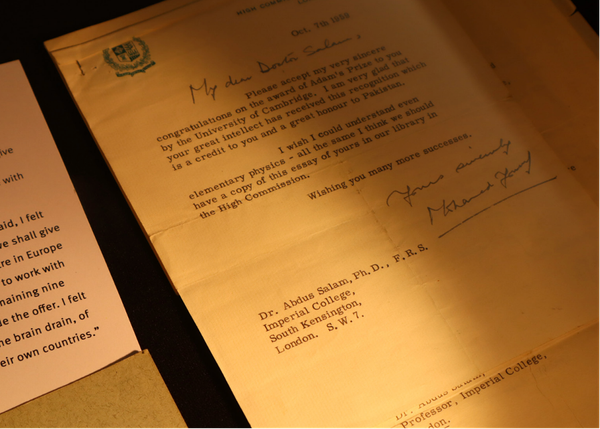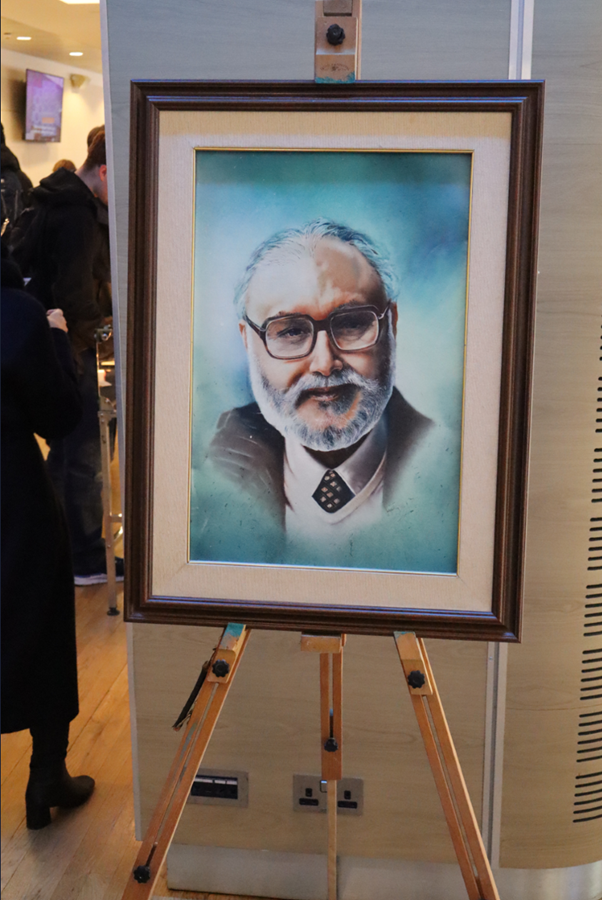ICLR celebrates record-breaking hot-fire test of THANOS-R engine
Imperial College London Rocketry test marks one of the first collegiate firings worldwide of a 3D-printed aluminium alloy engine.

On 11th February, the Imperial College London Rocketry team (ICLR) successfully tested their rocket engine on the Silwood Park campus testing facility. This was their most powerful test yet, with the rocket attaining a peak thrust of 3.8kN for two seconds. The engine subject to the hot fire is called THANOS-R. This is an improved engine compared to its predecessor, THANOS, which ICLR hot-fired in September last year, achieving a peak thrust of 3.2kN.
THANOS-R is a 3D printed, regeneratively cooled liquid rocket engine, which makes it reusable without the need to replace any of its engine components. The test marked one of the first collegiate firings worldwide of an engine 3D printed using a lightweight aluminium alloy, AlSi10Mg.
The society hopes to achieve longer burns with their reusable engine in future tests. This is in anticipation of this year’s European Rocketry Challenge (EuRoC) in Portugal, where ICLR will be launching their rocket, Nimbus.
I was fortunate to attend the test fire on the day, and caught up with propulsion engineers Elliott Brookes-Gayton and Martin England to discuss ICLR’s engine test.
“It went very well – we got performance close to what we expected, in some areas it exceeded the performance of our worst case scenario. As a preliminary test it went well: now that we can prove the engine has ignited and that we can show it can reach a thermal steady state under our most conservative conditions, we’re ready to go up to full duration burn and start increasing performance further.”
For us, it’s about getting higher thrusts, longer burns, and the regen engine opens up that opportunity.
ICLR is a student-led team composed of undergrad students across all discisplines at Imperial. Since their creation in 2018, the team has welcomed over 100 students to work on their rockets.
Members of ICLR are grouped into different subteams, each having an individual collective and goal. There are seven of these sub-teams: airframe and recovery (aim to avoid rapid unscheduled disassembly or descent), electronics (ensure telemetry, sensors, and video cameras are installed), propulsion (responsible for the engine), altitude record team (aim to break UK altitude record for amateur rocketry), payload (responsible for making payload to send on rockets in competitions), flight dynamics (responsible for the dynamic modelling of flight), and business and marketing (specialising in outreach and merchandising).
Elliott and Martin are both Mechanical Engineering students. They’ve been working with ICLR for over two years. Starting off as propulsion engineers, Elliott is now the Propulsion Team Lead, while Martin is the Propulsion Technical Lead.
“If you treat our team in isolation, our aim is to develop propulsion systems. You can have higher thrust, you can have longer duration burns, and you can have more efficiency, realistically. For us, it’s about getting higher thrusts, longer burns, and the regen opens up that opportunity to have much longer burns. In theory, you can burn non-stop provided the fuel tanks are big enough, but our focus is on having more efficiency and more burn duration.”
THANOS-R is a liquid bipropellant rocket engine, which uses both a liquid fuel and an oxidiser. Together they mix and are burnt at high pressures in a combustion chamber – the exhaust gas generated is accelerated through a nozzle, which generates the thrust.
“In a rocket, you have a fuel and an oxidiser, the aim is to burn it and release the chemical energy from the propellant. Every time you burn something, you increase the heat, and if this is done in a confined space, that increase in heat is going to manifest as an increase in pressure. When you pass a pressurised fluid through a converging-diverging nozzle, contrary to intuition, this process actually accelerates the gas, converting all the thermal energy into kinetic energy of the exhaust gas. Multiply velocity with mass flow, you get thrust. And so, the main aim of the engine is to take the propellant, extract its chemical energy and convert it to thermal energy – then accelerate it, expelling momentum out of the rocket.”
“It’s all about throwing as much mass as fast as you can out of the rocket. The faster you can throw it, the more efficiency you have.”
THANOS-R demonstrated a new cooling system onboard their engine, called regenerative cooling, which will allow the engine to be fully reuseable without replacing any components.
“With this engine, we use the fuel as a coolant first. Running a cool fluid about a hot chamber prevents the melting of the engine’s interior, making the engine regenerative with some additional efficiency perks.”
“With the engine implemented onto a rocket right now, our altitude targets are modest, but over time, they’re going to go up and up. Having an expendable platform, and technology that we can continue to develop, is quite nice.”
“Me and Martin spent more than a working week’s worth of work. In the week of the hotfire, we spent more time on the hotfire than our degree, by far. On the weekend, people that were there did more than a part time job just being there and working.”
“Martin and I are two mechanical engineers, though the society was originally started out of the Aeronautics department. As it’s gone along, the society is starting to see support coming in from Mech Eng. We’re actively expanding to Physics and EEE, with the basis that anyone who wants to join is welcome to join. Anybody is welcome to join if you’re into this. Some people are here for the vibes too – I’m fine with that, the vibes are good.”
It’s all about throwing as much mass as fast as you can out of the rocket. The faster you can throw it, the more efficiency you have.
This year, ICLR will be participating in two competitions. The first is the Race to Space competition, purely a propulsion competition, where teams have an opportunity to fire their engines. “They call it a competition, but really it’s an opportunity for these teams to fire their engines.
“We’re the only team that has a test site ourselves, on the Silwood Park campus, everybody else needs to use another one.
“Part of the collaboration with that is that you cannot compete unless you publicise all your documents, we’re not about trying to hide everything, we’re about everyone trying to learn, improve and do the cool stuff.”
The main competition for the team is EuRoC 2024, which will be taking place in October.
“We’ve been there for the past three years in a row; and our track record has not been great. We get very close, do pretty well, but it’s the last little bit that stumps us.”
The team also have ambitious plans to launch the first rocket of their size, type and calibre, in the UK.
“You can do it in all sorts of places in Europe and North America, there’s just nothing in the UK right now to launch liquid biopropellant and hybrid rockets. Potential sites include RAF bases, where they have a lot more land. We have a lot of people that need to agree to a lot of scary things to ask.”
From talking to Elliott and Martin, and all of the ICLR team members on the day of the test, their scientific feat is a testament to the unwavering dedication and collaborative spirit of the group. The 3D-printed, regeneratively-cooled liquid rocket engine marks a paradigm shift in propulsion technology, emphasising sustainability and reusability. As they set their sights on upcoming competitions like the Race to Space and EuRoC, the team’s aspirations extend beyond accolades and competition, aiming to carve a niche for themselves in the UK’s rocket launch landscape. The ICLR team’s journey is not just about reaching new heights in rocketry, but also about fostering a community of students pushing the boundaries of scientific exploration.
If you’re into rocket science or just want to soak up the good vibes, consider joining ICLR and sign up using the QR code. The team are an incredibly friendly bunch and the science and engineering they do is fantastic. All of us from Felix wish the ICLR team the best for their future tests and upcoming competitions!










